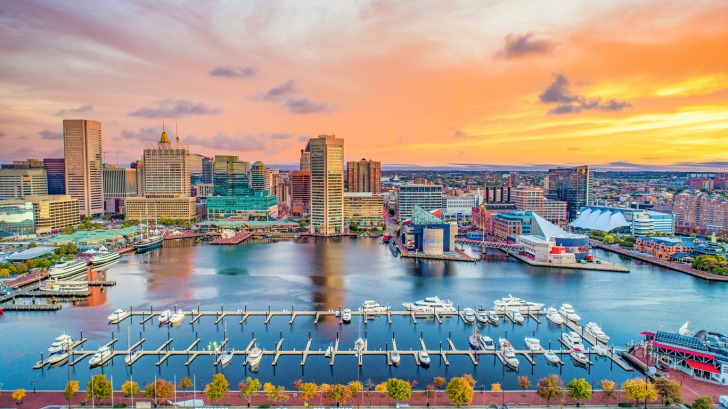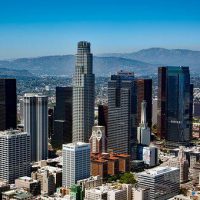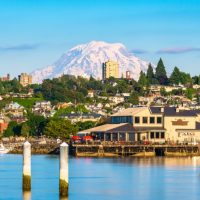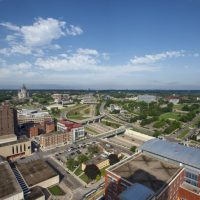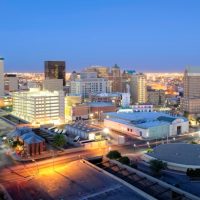Baltimore may not be the first place that comes to mind when considering a move to the East Coast.
Surprisingly, an increasing number of individuals are migrating from across the country as they are seeing the value in this city.
Earning the nickname “Charm City,” Baltimore lives up to its name with plenty of charming neighborhoods, history, shops, and restaurants.
Baltimore is known for the Inner Harbor area, endless entertainment options, hip and historic neighborhoods, and renowned attractions and museums.
Keep reading to learn more about the pros and cons of living in Baltimore!
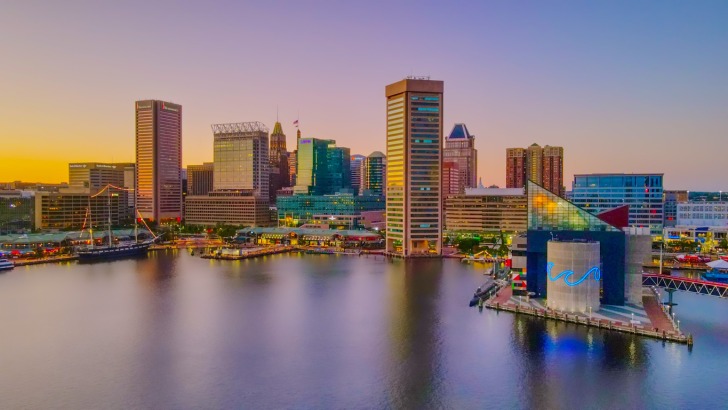
Contents
Pros of Living in Baltimore
Baltimore has plenty of wonderful aspects that must be considered when moving, including the following:
1. Amazing Food Scene
Founded in Baltimore, Old Bay adds a delicious spice to any seafood dish.
The Maryland Blue Crab considered the finest on Earth, is caught in the local Chesapeake Bay waters.
Seafood is a big part of the local food culture, so excellent fish, oysters, and lobster are available around town.
Since Baltimore is such a diverse city, there are plenty of ethnic restaurants to indulge in, ranging from Ethiopian to Chinese.
Therefore, if you are moving from a diverse city, Baltimore still gives you access to plenty of restaurant choices.
2. Beautiful Neighborhoods
Consider Baltimore if you are searching for charming neighborhoods with great neighborly vibes.
Baltimore boasts tremendous character and diversity, with over two hundred neighborhoods within the city limits.
Iconic row houses, peaceful, edgy, luxurious, trendy, artsy, hipster, and newly revitalized areas are all available in Baltimore, many at an affordable price.
The best neighborhoods include Federal Hill, Hampden, Mt. Vernon, Charles Village, and Fells Point.
3. Deep History
Often overshadowed by D.C. and Philadelphia, Baltimore boasts tremendous history.
The American National Anthem sings about the flag remaining at Fort McHenry in the city.
Edgar Allen Poe got his start as a writer in Baltimore.
The U.S.’s oldest railroad, the Baltimore and Ohio, began in Baltimore.
Babe Ruth was born in the city, John Wilkes Booth was buried in a local cemetery, and Frederick Douglas escaped from Baltimore during slavery.
4. Excellent Recreation Options
Locals report that one of the best aspects of Baltimore is the number of green spaces scattered throughout the city.
Also, Baltimore boasts a solid bike infrastructure, ideal for commuting or exercising.
Kayaking is a popular activity with the harbor, lakes, and rivers giving locals water access.
The best parks include Sherwood Gardens, Baltimore Conservatory, and Patterson Park.
For those seeking national parks, Revolutionary War battlefields, like Antietam, are nearby, as is Harpers Ferry.
5. High Affordability
Compared to other East Coast cities, Baltimore has a low cost of living with general affordability on everyday items and housing.
Your dollar will go much further in Baltimore compared to Washington and New York.
Baltimore is ranked third in the U.S. for affordability despite only being an hour away from expensive D.C.
An individual can live comfortably in Baltimore, making $49,800 per year, less than the average national income.
6. Large Job Market
Due to its proximity to Washington, Baltimore offers plenty of job opportunities.
It is reasonable to work in D.C., where you can earn a higher salary, but live in Baltimore.
The train from Downtown Baltimore to D.C. is only 30 minutes.
If you do not want to commute far, the average annual Baltimore salary is $62,000, which exceeds the national average.
The market is best for those in the healthcare industry, with the University of Maryland and Johns Hopkins nearby.
7. Lively Culture
Baltimore boasts many cultural spaces, from edgy art scenes to lively music halls, vibrant theaters, and world-class museums.
Some of the best venues include Artscape, The American Visionary Art Museum, the Baltimore Museum of Art, and the Walters Museum of Art are scattered around the city.
Also, Fluid Movement, Centerstage, Single Carrot Theater, and Fell’s Point Corner Theater are all excellent places to catch a show.
Music lovers will enjoy the Cat’s Eye Pub and Ottobar for live music, and the Baltimore Symphony Orchestra for a higher society feel.
8. Prime Location
One of the best aspects of living in Baltimore is the ideal location on the East Coast relative to other interesting, major cities.
The I-95 corridor is riddled with traffic, so rail is the quickest transportation method between Baltimore, Washington, Philadelphia, and New York.
The furthest city is New York, which can be reached in one hour by plane, 2.5 hours by train, and 3.5 hours by car.
Even Boston, a seven-hour drive from Baltimore, is a reasonable distance for a weekend trip.
9. Professional Sports Teams
In addition to the extensive nightlife, cultural options, and attractions, Baltimore has the Baltimore Orioles (baseball) and Baltimore Ravens (football) professional sports teams.
For those who prefer hockey and basketball, Washington is a short ride away, which boasts the Washington Capitals and Washington Wizards.
Additionally, several Division I schools are in the area, like the University of Maryland, Navy, and Towson University, if you want to catch some college football action.
Cons of Living in Baltimore
Like with any city, Baltimore is not perfect, so it’s important also to understand the drawbacks to living in Baltimore, including the following:
1. Brutal Summer Weather
For those moving from another East Coast city to Baltimore, you will be used to the hot and humid summers.
However, suppose you come from a dry area or location with a mild year-round climate. In that case, the swelting heat and sticky humidity can become incredibly uncomfortable, so you will not go outside during the summer.
2. Crime Problem
One of the biggest downsides to living in Baltimore is the high crime rate.
In 2022, Baltimore was ranked the fifth least safe city in the U.S.
In many major cities, pockets of crime exist in specific areas; in Baltimore, crime-ridden neighborhoods are adjacent to affluent areas, which means crime spills into other areas.
Muggings are common around the city, so it is important to keep your guard up.
3. Dirty City
There is no easy way to say this, but Baltimore is dirty.
Litter, trash, vandalism, and graffiti are prevalent across the city.
You adjust to the dirtiness until you visit a clean and graffiti-free city.
If having clean sidewalks is important, then Baltimore may not be the best destination.
4. Harsh Winters
The sometimes harsh winters are at the other end of the spectrum from the summer.
Although Baltimore gets less snow and ice than Boston or New York, the city is not immune to massive snowstorms.
Like in the summer, the amount of snow, cold weather, and ice can prevent you from wanting to leave the house.
With poor mass transit options, icey weather wreaks havoc on the roads, which can become incredibly dangerous.
5. Heavy Traffic
As a result of the subpart mass transit options, most Baltimore residents must own a car.
Therefore, during peak rush hour commuting times, the traffic can be horrendous, especially between Baltimore and Washington.
Also, since Baltimore is located on I-95, a major Northeastern thoroughfare, the number of travelers going in both directions adds to the congestion and traffic issue that plagues the area.
6. Poor Public Schools
Baltimore public schools regularly rank near the bottom of the list for public school quality.
This can be a major downside for those with children or looking to start a family.
On a positive note, many surrounding suburbs boast excellent schools that can make up for the city school districts.
However, if you are looking for an urban vibe, you may want to consider placing your children in private schools if moving to the city.
7. Pronounced Poverty
Although Baltimore is ranked 30th in the country for poverty rates, it feels much more pronounced than in other major cities.
One typical example is the squeegee kids, who will run up to your car to squeeze the windows and demand money without asking.
Although it is hard to blame kids for trying to earn extra money, the experience can be jarring and uncomfortable and a sign of the poverty that plagues the city.
8. Subpar Mass Transit
For those moving from a large city with excellent mass transit, prepare to be disappointed with Baltimore.
While public transit exists, large portions of the city are adequately covered.
Many residents are uncomfortable riding a bicycle when living outside the core areas.
Therefore, a car is necessary to get around town.
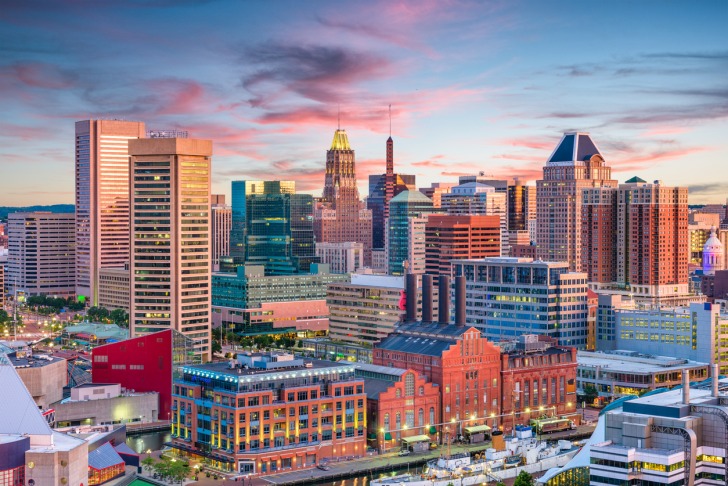
Pros and Cons of Living in Baltimore, MD – Summary Table
| Pros of Living in Baltimore | Cons of Living in Baltimore |
|---|---|
| 1. Amazing Food Scene | 1. Brutal Summer Weather |
| 2. Beautiful Neighborhoods | 2. Crime Problem |
| 3. Deep History | 3. Dirty City |
| 4. Excellent Recreation Options | 4. Harsh Winters |
| 5. High Affordability | 5. Heavy Traffic |
| 6. Large Job Market | 6. Poor Public Schools |
| 7. Lively Culture | 7. Pronounced Poverty |
| 8. Prime Location | 8. Subpar Mass Transit |
| 9. Professional Sports Teams |
Baltimore Safety Overview
READ THE FULL REPORT: Baltimore Safety Review
Safety Index:
- OVERALL RISK: HIGH
- TRANSPORT & TAXIS RISK: MEDIUM
- PICKPOCKETS RISK: MEDIUM
- NATURAL DISASTERS RISK: HIGH
- MUGGING RISK: HIGH
- TERRORISM RISK: MEDIUM
- SCAMS RISK: MEDIUM
- WOMEN TRAVELERS RISK: MEDIUM
Frequently Asked Questions
How many days of sunshine does Baltimore receive?
On average, Baltimore receives 213 days of sunshine annually, which exceeds the national average by around one week.
Its proximity to the ocean makes for some excellent beach days on the weekends to escape the heat and humidity common to the summer.
What is Baltimore’s population?
The city of Baltimore has a population of 576,000 residents.
Since Baltimore is part of the Washington-Baltimore metropolitan area, the surrounding region has a population of around six million residents, which continues to the traffic issues.
What is the most walkable area of Baltimore?
Boasting an impressive walkability score of 98, Mount Vernon is the city’s most walkable neighborhood.
Mount Vernon is well connected to mass transit, with plenty of entertainment, shopping, and schools within easy walking distance.
What are some of the best neighborhoods in Baltimore?
Although this question is subjective, several popular neighborhoods include Butcher’s Hill, Wyman Park, and Tuscany-Canterbury.
Is Baltimore a good place to live?
In general, residents of Baltimore enjoy living in the city.
While there are plenty of undesirable aspects of living in the city, the key to happiness is finding the right neighborhood that works for your budget and what negative aspects you can tolerate.
Finding that balance in Baltimore, and it does exist, is important to meeting your living and working needs.
